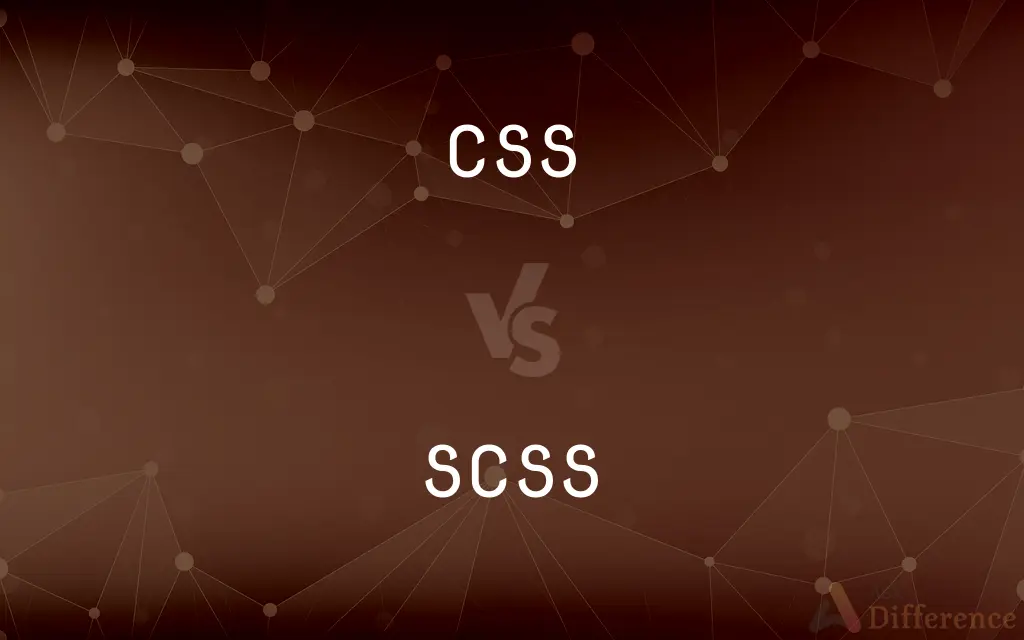CSS vs. SCSS — What's the Difference?
Edited by Tayyaba Rehman — By Fiza Rafique — Published on January 13, 2024
CSS stands for Cascading Style Sheets, a stylesheet language for styling HTML. SCSS is Sassy CSS, an extension of CSS with features of a programming language.

Difference Between CSS and SCSS
Table of Contents
ADVERTISEMENT
Key Differences
CSS, or Cascading Style Sheets, is a stylesheet language used to describe the presentation of a document written in HTML. SCSS, or Sassy CSS, is an extension of CSS that adds capabilities like variables, nesting, and mixins, which make the CSS more maintainable and easier to write. Both are used in web development to control the look and feel of websites, but SCSS allows for a more modular and programmatically complex approach.
CSS is the standard stylesheet language for defining web page styles and is universally supported by all web browsers. On the other hand, SCSS is a preprocessor scripting language that compiles down to CSS. SCSS is designed to make writing CSS more efficient and to introduce more powerful design patterns into the styling workflow.
With CSS, the developer writes styles in a straightforward manner without the use of variables or functions. SCSS, however, provides a more dynamic way of writing styles using variables, functions, and other constructs, which are not present in plain CSS. Both languages are crucial in web design, but SCSS offers a more powerful syntax for developers who need more advanced features.
CSS is limited to the features that are currently available in the CSS specifications defined by the World Wide Web Consortium (W3C). SCSS extends these capabilities, allowing developers to use logic and other programming constructs in their stylesheets, which ultimately compile into standard CSS that can be understood by browsers.
Lastly, while CSS is directly applied to a website and affects the visual rendering, SCSS files must first be compiled into regular CSS using tools like Sass before they can be used on a website. Both CSS and SCSS are critical tools in a web developer's toolkit, but SCSS's features are aimed at making the CSS coding process more efficient and less repetitive.
ADVERTISEMENT
Comparison Chart
Syntax
Uses standard CSS syntax.
Uses CSS-compatible syntax with extra features.
Variables
No variables; static values only.
Supports variables for dynamic content.
Nesting
No nesting; selectors are independent.
Allows nesting, which mirrors HTML structure.
Compilation
Directly used by browsers without compiling.
Must be compiled into CSS to be browser-readable.
Features
Limited to what current CSS3 offers.
Extends CSS with features like mixins, inheritance.
Programming Constructs
None; it’s a markup language.
Includes programming constructs like loops and conditions.
Compare with Definitions
CSS
A styling language that defines the look of HTML content.
The website’s layout was broken until I corrected the CSS.
SCSS
Supports nesting, functions, and mixins for more dynamic styles.
Using nesting in SCSS kept the stylesheet well-organized.
CSS
It's independent of HTML but typically used to style HTML pages.
The HTML was complete, but it needed CSS for visual polish.
SCSS
Syntax is fully compatible with CSS, but also allows variables.
Variables in SCSS streamlined the color scheme changes.
CSS
Cascading rules determine which styles are applied in conflicts.
Cascading rules in CSS resolved the conflicting styles.
SCSS
Makes maintenance and scalability easier for large stylesheets.
SCSS reduced the time required for stylesheet maintenance.
CSS
CSS3 is the latest evolution, adding animations and transitions.
With CSS3, the menu gained smooth transitions.
SCSS
Must be compiled into CSS to be understood by web browsers.
After editing the SCSS, I compiled it to update the site’s CSS.
CSS
Controls web design elements like colors, fonts, and spacing.
Changing the CSS altered the text’s appearance instantly.
SCSS
An extension of CSS that adds programming features.
SCSS made it easier to manage the site’s complex styles.
Common Curiosities
What does SCSS stand for?
SCSS stands for Sassy CSS, which is a syntax for Sass, a CSS preprocessor.
What feature does SCSS add to CSS?
SCSS adds features like variables, nesting, and mixins to standard CSS.
Is SCSS compatible with CSS?
Yes, SCSS is fully compatible with CSS and all valid CSS is valid SCSS as well.
What is the main benefit of using SCSS over CSS?
SCSS simplifies and enhances the process of writing CSS with more advanced features.
Can CSS and SCSS be used together in a project?
Yes, because SCSS compiles to CSS, they can be used together seamlessly.
What is CSS?
CSS stands for Cascading Style Sheets, a language for applying styles to HTML documents.
Can I use CSS frameworks with SCSS?
Yes, CSS frameworks can be used with SCSS since SCSS compiles down to standard CSS.
Does using SCSS improve website performance?
SCSS does not directly impact performance; it makes writing and maintaining styles more efficient.
Can browsers read SCSS directly?
No, browsers cannot read SCSS directly. It must be compiled into standard CSS.
How does CSS handle variables?
CSS does not natively support variables; instead, it uses static values.
Do I need a special program to compile SCSS into CSS?
Yes, you need a Sass compiler to convert SCSS into CSS.
How do I include CSS in my HTML?
CSS can be included internally, linked externally, or inline within HTML tags.
What are mixins in SCSS?
Mixins in SCSS are reusable pieces of code that can be included in other SCSS selectors.
How do I include SCSS in my project?
You include SCSS by compiling it to CSS and then including that CSS in your HTML.
Do I have to learn CSS before SCSS?
While not mandatory, learning CSS before SCSS is beneficial since SCSS builds upon CSS concepts.
Share Your Discovery

Previous Comparison
Jiggly vs. Jumpy
Next Comparison
Short Term Capital Gain vs. Long Term Capital GainAuthor Spotlight
Written by
Fiza RafiqueFiza Rafique is a skilled content writer at AskDifference.com, where she meticulously refines and enhances written pieces. Drawing from her vast editorial expertise, Fiza ensures clarity, accuracy, and precision in every article. Passionate about language, she continually seeks to elevate the quality of content for readers worldwide.
Edited by
Tayyaba RehmanTayyaba Rehman is a distinguished writer, currently serving as a primary contributor to askdifference.com. As a researcher in semantics and etymology, Tayyaba's passion for the complexity of languages and their distinctions has found a perfect home on the platform. Tayyaba delves into the intricacies of language, distinguishing between commonly confused words and phrases, thereby providing clarity for readers worldwide.












































